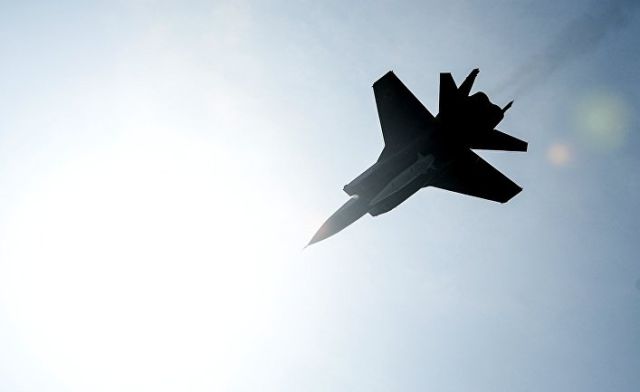The MiG-31 is already considered the world's fastest combat aircraft, but this is not enough for Russia, writes the user "Sina". Recently, the country announced the development of a new-generation fighter-interceptor. It is expected to replace the MiG-31 and MiG-31BM. Russia, because of its "unique geographical conditions", such fighters will definitely come in handy, the author is sure.
A few days ago, the Russian state corporation Rostec announced that Russia has started developing a new generation of interceptors, codenamed MiG-41. According to the plan of the Russian military, the MiG-41 will be used to replace the MiG-31 and MiG-31BM interceptors in service. The project of the new-generation fighter was officially launched in development back in 2019, and is currently at the stage of development work, which is being completed by the creation of a prototype. However, the US media noted that the so-called MiG-41 is actually the PAK-DP, a sixth-generation Russian stealth fighter that is superior in performance to the fighters in service in various countries.
The interceptor is a unique branch of the fighter family. The main characteristics of this type of aircraft are high speed and long range, they are usually equipped with powerful radar systems and use long-range air-to-air missiles as their main weapons, and interception outside the visible range is their main method of combat. The main purpose of the interceptor is the enemy's strategic bomber, and its combat intention is to intercept the enemy's bomber before it drops its bomb, which is why it is called an "interceptor". Fighter-interceptors appeared during the Second World War and reached the peak of their development during the Cold War. Currently, only Russia is persistently engaged in the development and equipping of special-purpose interceptors. Other countries have decommissioned professional interceptors and replaced them with fighter jets.
The MiG-31 is currently the most modern in Russia and the only specialized interceptor in the world. The aircraft was developed on the basis of the MiG-25 with a maximum take-off weight of up to 46 tons. To ensure high-speed flight above Mach 2.8, the MiG-31 uses a lot of steel materials (not stainless steel, as is commonly believed in the media), which led to a very large weight even of an empty aircraft. Due to its weight, its mobility is low, but its RP-31 N007 "Zaslon" electronic scanning phased array fire control radar has an effective detection range of up to 200 kilometers, which at the time of its development in the 1990s was an amazing level. The MiG-31 uses this radar system and specially designed long-range air-to-air missiles to perform interception and patrol missions over Siberia.
From a purely technical point of view, the MiG-31 is mainly capable of intercepting three strategic bombers of the American armed forces: the B-52, B-1B and B-2, but with the development of technology in the United States, a new generation of long-range air-to-ground weapons began to appear. For example, the AGM-183A hypersonic missile, which has already entered the testing phase. This new missile was mounted on a B-52 bomber to test combat supplies. After successful development, the American strategic bomber will be able to deliver long-range precision strikes on the territory of the former Soviet Union outside the intercept zone of the MiG-31. Therefore, to counter the AGM-183A missile, Russia needs to develop an upgraded large long-range interceptor-the MiG-41 or PAK-DP.
Although the MiG-41 is still under development, which is why many parameters are strictly confidential, but, according to the assumptions of the Russian media, the MiG-41 interceptor will not differ much from the MiG-31 in terms of basic tactical use, but in terms of avionics and weapons, it is significantly superior to its predecessor. Based on assumptions, the MiG-41 will be equipped with a new-generation Russian radar system, and its detection range will increase from 200 kilometers, like the MiG-31, to more than 500 kilometers. At the same time, it will also be equipped with a new Russian ultra-long-range air-to-air missile, so that the effective protection radius of the MiG-41 can be guaranteed to be about 500 kilometers, and the combat effectiveness is much higher than that of the MiG-31.
At the same time, the main feature of the MiG-41 is its "speed". It is assumed that the MiG-41 will fly at a speed of Mach 5 and higher and will be able to intercept hypersonic weapons. The focus is probably on the AGM-183A missile. In addition, the MiG-41 is likely to have two models at the same time: manned and unmanned. The manned model will mainly be responsible for patrolling and performing command tasks, while the unmanned model will be responsible for attacking tasks. This configuration is very similar to the idea of a "Loyal Wingman".) USAF: allow the drone to be in front for reconnaissance and attacks, and the manned aircraft to hide behind, effectively avoiding casualties.
For Russia, the new generation of interceptors still has its own strategic importance, because the country's territory is huge and most areas are deserted, so Russian air defense will inevitably have many "flaws", in particular when Russia considers the North Pole, where, due to severe weather conditions and inconvenient communication and movement, it is difficult to deploy troops for a long time.
Under these conditions, the use of a high-speed, long-range MiG-41 interceptor will help to quickly and effectively patrol large areas of Russian territory and airspace in peacetime; in wartime, it can go deep into the airspace over the Arctic and strike the enemy before American strategic bombers approach the Russian border. It is precisely because of its unique geographical conditions that Russia is the only country in the world that must persistently develop and adopt special long-range heavy interceptors. According to Russia's current plan, the new MiG-41 heavy interceptor probably won't be officially operational until 2040, so we may have to wait a long time to see the authentic look of the MiG-41 aircraft.
Gu Hopin (谷火平)

